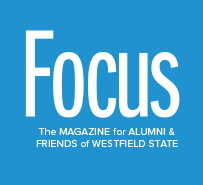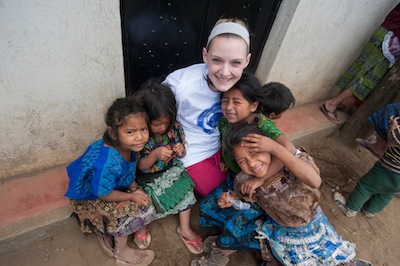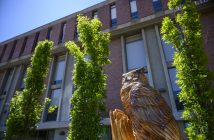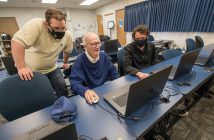Giving students the tools they will need as caregivers
The trip offered the upcoming nurses the opportunity to be part of the civic engagement initiative at Westfield State. (See related stories, pages 20–21.) It was the first time students traveled to Guatemala on a medical and public health mission, and they spent a week guided by Karen Manning, Ed.D. and Marcia Scanlon, D.NP, Department of Nursing and Allied Health professors.
Arriving in Antigua, the students had a full itinerary. They built wheelchairs, installed water filters and cared for children at two different orphanages. They also provided health and dental care for children and wound care for the homeless, volunteered at a hospital, fed and played with children at a malnutrition center and built a house.
It was “the experience of a lifetime,” as nursing student Meghan O’Brien ’15 says.
Dr. Scanlon believes traveling to Guatemala helped the students broaden their understanding of healthcare in other countries. “Our main goal was to increase students’ awareness and appreciation of other cultures,” she says. “Nurses care for many diverse patients, and exposure to different cultures is beneficial. It prepared them to be better future nurses—being more culturally aware and competent in delivering care to diverse patients.”
“They worked so hard for months fundraising,” adds Dr. Manning. “The nursing students are such a cohesive group and worked together on this project. They put on a spaghetti dinner, left donation boxes at doctors’ and dentists’ offices and hospitals, and sought donations from many businesses.”
Nursing student Jennifer Torres ’15 says, “We put donation boxes everywhere we could think of.”
The campus community supported this civic engagement. The Office of International Programs, for instance, contributed funds for the trip, as did staff and faculty with private donations.
The efforts paid off. The nursing students left with everything from vitamins to money to toothbrushes to jump ropes. Their determination and enthusiasm succeeded in getting everyone on board.
The students stayed directly across the street from the Christian mission that was coordinating their community service.
The first day was spent at Hope Haven, an organization that collects donated wheelchairs and wheelchair parts from around the world and distributes them to people who need them.
The nursing students, led by a Hope Haven volunteer, learned how to measure and fit four children to wheelchairs. “Every body doesn’t fit into every wheelchair,” says Dr. Manning. “We were customizing the chairs to fit the ‘individual.’ For instance, the students had to customize a wheelchair for a child with spina bifida to accommodate the shape of his back.
“None of us had ever assembled a wheelchair,” says O’Brien, “and they didn’t come as we expected: in boxes with directions. We needed to study other wheelchairs to figure out how to assemble and customize them.”
The students spent hours rummaging through the large warehouse to find the right parts and tools. “We learned so much about the independence a wheelchair can offer,” says Torres. “There was one boy who couldn’t go to school because his brother had to carry him everywhere. Before getting his wheelchair, he spent all day restricted to sitting in a lawn chair.”
During the week, the group often split into two, so that they were able to perform service in more areas. According to Dr. Scanlon, more than half the population of Guatemala lives below the international poverty line, and the children suffer from chronic malnutrition.
Water in Guatemala is generally rationed every three or four days and transported in buckets. It was not uncommon to see water rations stored in worn and dirty basins outside homes. Water for drinking had to be boiled to remove bacteria.
“We installed and taught the families how to use the donated Sawyer water filters,” says O’Brien. The filters will purify up to 10,000 gallons of water.
O’Brien and her classmates were shocked by the poverty and the living situations.
“Many of the residents lived in one-room shacks with cornstalk walls and dirt floors,” she says. “You were considered ‘well-off’ if you had a concrete floor.” And, for one family, University students built a metal house with a concrete floor.
“What we would consider a tool shed is a coveted home to the Guatemalan people,” says Dr. Manning.
When the house was completed, the large family was overcome with gratitude. “It was very emotional for all of us,” says Torres.
The students also worked at a nutrition center. The Guatemalan children lack protein in their diets, and this affects their growth. A wealthy Guatemalan restaurant owner donates his garage a few days a week, as a nutrition center for children.
University students offered snack and juice and a physical activity for preschool children. The nursing students also took the children’s weight, height and blood pressure and practiced hand washing and tooth brushing with them.
“We matched the kids up to growth charts, and their teachers were very interested in knowing if there were any children they should ‘watch,’” says Dr. Manning.
Dr. Scanlon says the civic engagement learning experience helped students become better nurses because the service they provided was outside a typical nursing environment.
“It broadened their scope and vision of the nursing profession to include communities all over the world— not just patients in a hospital setting,” Dr. Scanlon says. “It promoted nursing qualities such as leadership, teamwork, respect and problem-solving skills.”




